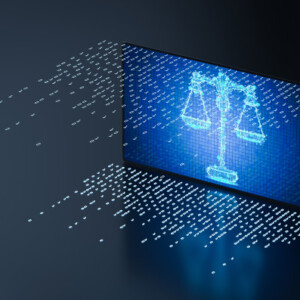Recently, I have read an article on AntyWeb.pl about a game in which you are a kind of Robinson Crusoe in a world occupied by zombies, or rather about the theft of its idea (link: INDEPENDENT DEVELOPER REFUSED TO COOPERATE WITH PUBLISHER, SO THE LATTER COPIED HIS IDEAS AND PUBLISHED IT AS ITS OWN PRODUCT). This publication, together with a recent case of our Client, where its contractor claims that it should be entitled to the copyright to the concept of an advertising campaign, gave rise to the topic of another article, namely: protection of an idea in light of the Act on copyright and related rights of 4 February 1994 (subsequently: Act).
Our regular readers are surely aware that “The object of copyright shall be any manifestation of creative activity of individual nature, established in any form (…),” that is a work. Further, according to the PWN dictionary, “an idea” (used here alternately with “a concept”) is «a creative thought involving a project of action, settlement of something». The adjective “creative” fits into place, but how does “a thought” work in the context of “ established in any form”? A thought or idea is as a principle something abstract, which cannot be presented in a material form. From this it results that the protection based on the provisions of the copyright law is established upon “externalizing”, establishing a work which enables it to be perceived by persons other than the creator. This is additionally proved by Article 1 section 2[1] of the Act, according to which “Protection may apply to the form of expression only and no protection shall be granted to discoveries, ideas, procedures, methods and principles of operation as well as mathematical concepts.” So originally, i.e. when a work is only in the author’s consciousness (is an idea, concept)–there are no grounds to grant it protection under copyright.
Establishing (according to the rule of the Supreme Court of 25 April 1973) should be understood as a work’s assuming of any form, even an impermanent one, yet so stable to enable its features and content to give an artistic effect. The doctrine states also that if a work can be
established in any form, its protection comes into effect without the necessity of its “establishment” meant as recording on a material medium–thus, it is enough to perform a music improvisation or to present a paper, without the need to fix them on physical objects (in score, on audiotape or CD). The protection of a work commences upon its externalization (expression), which is the condition of producing a work.
For many of you it is bad news–respective jurisdiction approach in this matter is consistent and has not been changed yet– you cannot claim an illegal use of another person’s work which would consist in becoming familiar with its content, particularly if it was voluntarily made available to another person. An author’s right is also not infringed if another person, even contrary to author’s will, assimilates certain content of the original work without using the work or its fragments in its formal and content-related sense.
It is not by coincidence that our Client has referred to us with the concerned case–the issue of idea protection raises perhaps most often in the advertising activity. Presumably, it is connected with a dichotomous division of roles in the process of creating advertisement into a person with an idea (idea men, creative workers) and a person executing the idea. On the grounds of this division, three approaches has developed in the literature of the subject:
- an idea is “nothing”, execution is “everything”,
- an idea is “everything”, execution is “nothing”,
- an idea and execution work together.
You can easily guess, considering the foregoing, that in light of the Act the first approach wins–execution will be the object of the copyright protection. To prove this statement a court order should be invoked in which the subject matter of the settlement was the factual state with a similar division of roles–the plaintiff presented the defendant the conception of an advertising campaign, what’s more, described it quite precisely (a picture of snow-covered mountains in summer etc.) and left documents depicting its graphic outline. The court clearly stated, though, that a work is in opposition to ideas for an advertising campaign. What’s more, a work is meant as a whole and not as its particular elements (consequently, also an idea which indisputably constitutes an element of the process of work production)–these are not subject to a separate protection (case file V ACa 175/12).
Furthermore, the doctrine and case law admit a concept of parallel creative activity, which provides for an independent development and execution of an identical or very similar work of art by two authors. It should be emphasized that the creative process has to proceed completely independently and the work has to lack any conscious or unconscious borrowings. In such case, a work which is a product of a completely independent creative process, even if its form and content are much similar to that of another work, is not a plagiarism.
Certainly, some of you, including eager thinkers, feel treated unfair. Such a manner of regulating an idea in the Act on copyright and related rights has its higher purpose, though. Exclusion of ideas from the copyright protection was supposed to prevent monopolization of human thoughts, which should be a common good, at least from the point of view of the copyright law. If an opposite assumption was adopted, then we could claim protection of practically every form of human activity referring to a factual or imaginary priority (I admit that it is not my approach, but an extract of court rulings with which I do not completely identify). It should be noted, however, that even if concepts are generally not subject to the copyright protection, this does not exclude their possible protection on general terms of the civil law.
DO YOU INVEST IN POLAND? YOU SHOULD BE AWARE OF THESE DIFFERENCES IN THE COPYRIGHT LAW
Polish entrepreneurs ever more eagerly extend their business beyond Poland. One of the main directions of their development is Silicon Valley. Expansion to the United States, however, entails numerous changes they have to cope with, one of them is the change of legal regime.
In such situations it is worth realizing at least basic legal differences and issues which will apply to them then.
One of basic capitals traded in the USA is intellectual property. Yet since discussion of legal regulations applicable to intellectual property in the USA would go far beyond one article, we decided to focus on particular aspects of the IP law. Today, we will analyze the issue of differences between the Polish and American copyright law.
Unfinished work
For the sake of convenience we have divided the article into particular issues which may be of key importance for those developing their business in the USA.
- In Poland, the copyright protection does not cover, among others, ideas, concepts, methods and rules of procedure. It is only the manner of their expression which can be protected; there is, however, a convenient restriction namely a work is in copyright since being established, even though its form is incomplete.
In the USA the copyright law is regulated by the Copyright Act of 1976 and pursuant to this act the copyright protection raises also automatically upon being established. Additionally, in the USA there is also the Copyright Office in place, where copyrights can, but have not to, be registered. It is definitely recommended, though, to register copyrights, as the Copyright Act provides persons who have made this with additional protection.
The key thing is that the work is fixed, i.e. recorded on a physical data media in a manner enabling its potential copying and disseminating. In Poland in turn, establishment, that is giving the work such a form in which it could potentially be received by third persons (also in e.g. audio form), is enough, i.e. it can be only said or played.
Of course, the Copyright Act prescribes also exceptions from the copyright protection, but such items are usually covered by another type of intellectual property (a trade mark or patent law). In fact, in the United States, fashion design generally enjoys no copyright protection, unless a particular item is subject to the separation doctrine. Recently, one of more interesting cases concerned whether the dress worn by Kate Perry at Met Gala infringed Rime’s (graffiti artist) copyrights. Among works excluded from the protection there are also unfixed works, titles or short phrases, ideas or products of purely utilitarian character.
Assignment or license?
- The Polish legislator prescribed that an agreement transferring proprietary copyrights and an exclusive license have to be concluded in writing in order to be valid. A non-exclusive license, by contrast, can be concluded e.g. in an electronic form or even implicitly.
In this scope, in the USA there functions copyright transfer, whereby it is very broadly defined—it covers transfer, lien, exclusive license and any other type of collaterals, as e.g. hypothecation of a copyright as a whole or of a single entitlement composing such right. This concept does not include only a non-exclusive license.
In this context, transfer of exclusive rights is effective only if proceeds in writing and is signed by the owner of the assigned rights. By contrast, non-exclusive transfer of rights does not require a written agreement (it is an implied license).
In the USA copyrights are usually transferred by means of assignment. Assignment of copyrights resembles sale of a movable property. The original owner sells his/her rights to a third party and, as a consequence, loses his/her control over the manner in which such third party uses those rights. As opposed to the implied license, we have an express license (which is an equivalent of Polish exclusive license)—it is an agreement under which the owner of a copyright retains the ownership of relevant rights, but agrees to a third party’s exercising of any or all such rights without fearing a charge of copyright infringement.
A license is a solution preferable to rights assignment if a holder of a copyright wants to remain their ownership or wants to exercise continuous control over the manner in which a third party exercises the rights of the copyright holder.
An implied copyright license is a license established under the law where parties failed to conclude a factual/written agreement. An implied license is established when parties’ actions suggest that the copyright owner had granted certain license to the licensee, but the parties have not prepared a license as such.
It should be noted, however, that a non-exclusive license does not entitle its holder to prohibit others from using a work, but more, such holder cannot at all raise any claims in the event of copyright infringement covered by such a license.
A document by virtue of which the copyright ownership is transferred can be registered in the Copyright Office. Even if the registration is not obligatory to conduct a valid copyright transfer, a registration document ensures certain legal advantages and can be required for the purpose of confirming the transfer to third parties.
Moral rights
- In Poland, as opposed to proprietary copyrights which are limited in terms of time, moral rights cannot be transferred to another person or waived. What is more, theoretically, they are not for ever. Still, you can authorize a counterparty to exercise them on behalf of the author or even undertake to refrain from exercising them.
In the USA in turn, the division into moral rights and proprietary copyrights is not so obvious. Instead, the Copyright Act provides for a concept of enumerative list of exclusive rights, which are the American equivalent of proprietary copyrights (these are: right to reproduce, prepare derivative works, distribute copies to the public, including by sale or other transfer of ownership, or by rental, lease or lending)
Moral rights do not play such an important role as in the Polish law, besides, they aim at protection of commercial trade rather than author’s “morals”, hence the more people are ready to pay for a work, the more effective they are. What’s more, they apply to works of visual arts only and the protection is narrow: an author can enjoy the right of attribution and the right of integrity. Additionally, despite the owner of copyrights can freely transfer his/her copyrights at own discretion, the Copyright Act provides for an irrevocable right of the copyright owner to cancel each transfer of the copyright. The aim of such solution is to give the work’s author (or his/her heirs) a second chance to use the work where its value can considerably increase since the original transfer.
In Poland, our equivalent of moral rights (osobiste prawa autorskie) is unlimited in terms of time, and in this context we can notice another difference between the two legislatures–in the USA copyrights are valid for 70 years (similarly as in the case of Polish proprietary copyrights). The American act prescribes also types of works which enjoy much longer protection. It mentions anonymous works, pseudonymous works or already discussed works made for hire–in these cases the copyright endures for a term of 95 years from the year of its first publication, or a term of 120 years from the year of its creation, whichever expires first.
Let’s go back to the American 70-year protection. Only until recently, the protection was valid 50 years, but in 1998 the so-called Mickey Mouse Protection Act was adopted, which extended the protection period by another 20 years. It requires no explanations why the Congress’s act was named this way–otherwise, Disney concern would make colossal amounts of
money on its animated characters until, among others, 2007. In this way, the Mickey Mouse character will be protected under the copyright further, until 2027.
Sublicense
- In Poland, if a license agreement fails to directly and expressly state that a licensee can grant sublicenses, it is not allowed to do so. Or if an agreement fails to directly provide that a counterparty can make amendments, modifications to a work or otherwise prepare derivative works (such as literary translation, music composition, reproduction), there is no such possibility.
In the USA the permission to create a derivative work and to grant adaptation rights can be given only by the owner of copyrights related to the work concerned. Introducing an unauthorized change to a work can constitute infringement of the copyright (it can, as changes made within the frames of fair use do not constitute infringement). Therefore, it is worth taking care of this from the practical side. For instance, if parties to a license agreement agreed that the licensee will be granted the right to make derivative works, then the parties should determine in the agreement who will enjoy the rights to such “new” work. Usually, it is the licensor who reserves such rights to his/her benefit, but it can also be so that the rights will be vested in both parties jointly.
When preparing an agreement, you should also make sure (if you plan to grant sublicenses) to clearly indicate such authorization for the licensee, as the Copyright Act does not regulate this issue directly. It is important as some American courts have not acknowledged the right to sublicense resulting from an exclusive license because this right should have been included in the written agreement between the parties.
When the author loses the rights
- In the Polish law (to put it very simply), what an employee has created in the course of performing his/her duties passes to the employer. It is even simpler with the industrial property rights–here the rights to inventions, utility models or industrial designs pass automatically within the frames of any agreement, not only an employment contract.
In the USA there is a specific institution “work made for hire”, under which the factual author of a work loses the position of the creator, while the employer or person ordering such a work is for the purpose of the act treated as the work’s author. This principle can be changed by means of a contractual clause. Companies, however, are not eager to waive the intellectual property right to the benefit of some employee.
In view of the above, it should be mentioned that in the American law a legal person can be the creator, whereas the Polish law provides only for a human being, that is a natural person.
Right to quote
- In Poland, we have various fair uses, namely situations in which we do not have to ask the author for permission to use his/her work and we do not have to pay him/her a remuneration on that account. Among the fair uses we can distinguish, among others, the right to quote and the right to reprint.
Arguably, in the USA the most common doctrine restricting the copyrights is exactly the fair use. The doctrine has been developed in the case law for years as the courts have tried to find the balance between the rights of copyright owners and arguments of the policy which allows copying in certain, precisely stated circumstances. The fundamental assumption of the fair use doctrine is that copying should not be completely prohibited, especially in the fields of social importance, such as criticism, news, education or research. Now, the fair use doctrine is also the subject matter of the Copyright Act. The act distinguishes four factors to be considered while settling if a given action constitutes a fair use: “the purpose and character of the use, including whether such use is of a commercial nature or is for nonprofit educational purposes; the nature of the copyrighted work; the amount and substantiality of the portion used in relation to the copyrighted work as a whole; and the effect of the use upon the potential market for or value of the copyrighted work.”
Certainly, now you guess that there are a lot more differences, nuisances and consequential exceptions in the copyright law, and this article is just tip of the iceberg of the legal aspects which are to be taken into account while setting off to conquer the USA. For sure, with support of appropriate persons the process of becoming familiar with the American law goes smoothly and painlessly.




